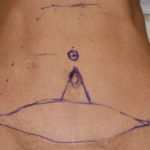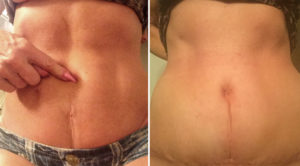Background: There are many benefits to tummy tuck surgery including a better shaped waistline due to the elimination of loose skin and extra fat. One of the ‘smaller’ benefits is in the creation of a new umbilicus. (belly button) A distorted and misshapen belly button often occurs due to the development of loose skin around it. As a result it can become stretched and lose its original taut and smaller appearance.
The final step in tummy tuck surgery is the creation of new umbilicus. Often referred to as getting a new belly button, this is only partially correct. Actually the original stalk of the belly button is maintained albeit shortened. What is new is the hole that is made through the overlying abdominal skin to bring it back up to the surface of the external abdominal wall.
Located in the center of the stomach, the appearance of the umbilicus is an important aspect of a tummy tuck result. While the size and shape of the belly button has aesthetic appeal, its midline and vertical orientation can be judged to be most important. No matter how good its shape may be, a belly button that is off center or sits too high or low can look odd. For this reason great attention is paid to getting the correct alignment for the placement of the delivery point of the old umbilical stalk. Getting it wrong can be problematic as belly buttons can be very difficult to reposition.
Case Study: This 55 year-old female had previously undergone a full tummy tuck. She was unhappy with the appearance of her new belly button as she felt it was too low. Her skin had relaxed somewhat in the year since her surgery.


Highlights:
1) The umbilicoplasty portion of a tummy tuck is one of the most visible aspects of the result.
2) A malpositioned belly button can be a very difficult problem to solve after a tummy tuck due to the tight skin and the shortened umbilical stalk.
3) In some cases of umbilical deformity a complete new belly button has to be created to put it in the right position. (neoumbilicoplasty)
Dr. Barry Eppley
Indianapolis, Indiana


